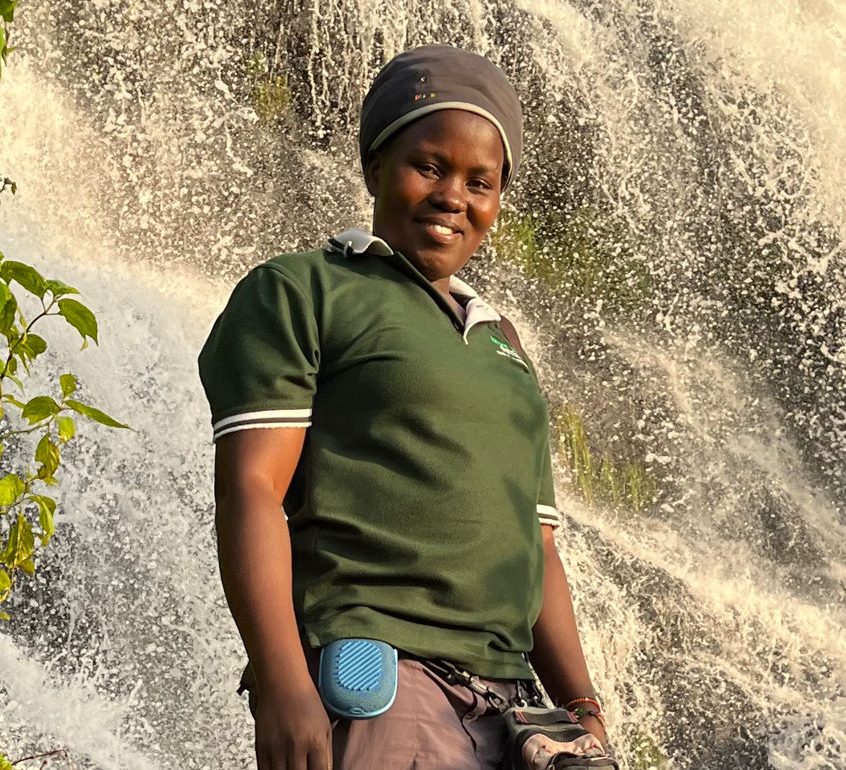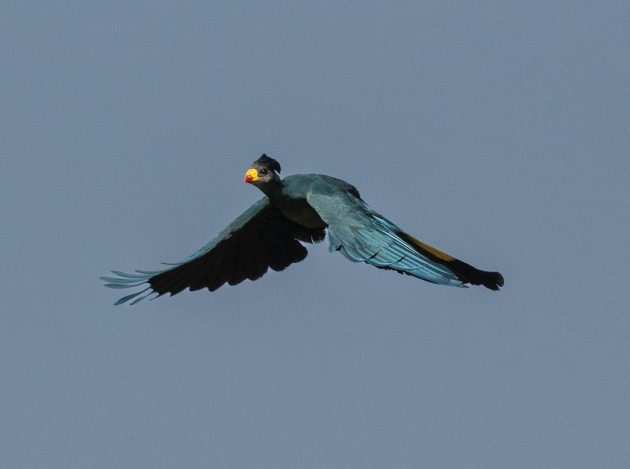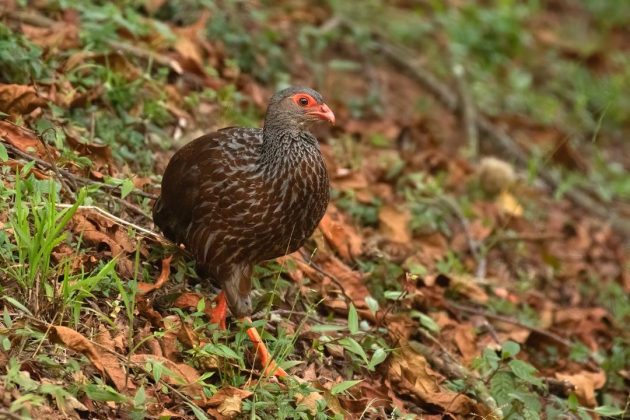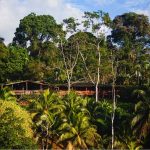
What is your favorite bird species?
Very difficult to choose among the many. All birds are special in their own way. If it comes to color combinations, all birds are beautiful, vocalizing all birds have special sounds.
What is your name, and where do you live?
My name is Prossy Nanyombi. I was born and live in Uganda. Specifically, I live in the Mpigi district just next to Mpanga forest reserve where I worked as a site guide from 2011-2019.
What are the main regions or locations you cover as a bird guide?
I cover all the birding spots within Uganda. I am a national bird guide registered with the Uganda Tourism Board.
How long have you been a bird guide?
I have been a bird guide since 2013.
How did you get into bird guiding?
I studied tourism management at university, and after school, I was posted in Mpanga forest for my internship as part of the course in 2011. Mpanga eco-tourism site where tourists could come for nature walks, bird watching and other activities was my workstation.
It wasn’t busy at all so I had plenty of time to hang around doing a lot of nothing. This is when I decided to start looking at birds to admire their beautiful colors, have fun, and of course to pass the time. I could use the site’s bird book (Birds of East Africa) for reference and to learn the names of the birds I could see. I had it as my daily routine, I eventually loved it and it became a hobby that I could do every day.
Towards the end of August 2011, Habert Byaruhanga came to Mpanga forest with clients on his way to Lake Mburo National Park and my supervisor introduced me to him. He asked me about several calls from the forest and I knew them all. He donated a pair of binoculars to me and offered to take me for a guide training. As a consequence of the guide training, my love and passion for birds increased. I continued practicing and traveling to different areas until 2013 when I did my first tour as a bird guide. The clients were extremely happy with my skills in identifying birds by ear and sight. Since then, I have led many trips in Uganda in all birding hotspots, both inside and outside of protected areas.
What are the aspects of being a bird guide that you like best? Which aspects do you dislike most?
I like every aspect as this is my passion. I dislike the aspect of habitat loss for our birds. Due to the increasing population and urbanization, some of the bird habitat is continuously lost. Sad!
What are the top 5-10 birds in your region that you think are the most interesting for visiting birders?
- Shoebill
- Green-breasted Pita
- Grauer’s Broadbill
- African Piculet
- Chocolate-backed Kingfisher
- Handsome Francolin
- Dwarf Kingfisher
- Nahan’s Francolin
- Rwenzori Nightjar
- Great-blue Turaco

Can you outline at least one typical birdwatching trip in your area? Please briefly describe the locations, the key birds, and the approximate duration of such a trip
A Uganda trip is flexible depending on the client’s interest and can be customized to suit their days and interests. A typical bird-watching trip can range between 14-20 days or more. It’s a loop to avoid backtracking.
Below is an outline of a 20-day bird-watching and primate tour.
Day 0: Arrival
Day1: Mabamba swamp and Botanical gardens
Mabamba swamp is a community-managed swamp located about 2 hours’ drive from Entebbe, and it is home to several pairs of Shoebill and other waterbirds.
Botanical Gardens is a leisure park located in Entebbe with over 200 species of birds including Bat Hawk and Orange Weaver.
Highlights: Shoebill, Malachite Kingfisher, Lesser Jacana, Purple Heron, Common Squacco Heron, Fan-tailed Widowbird, African Marsh Harrier and others.
Day 2: Birding to Lake Mburo NP
Lake Mburo National Park is Uganda’s smallest savanna park with an array of wildlife. It has the highest concentration of mammals including Impala, Zebra, Topi, Leopard, Giraffe, Eland, and many others.
Day3: Birding Lake Mburo plus a boat ride
Highlights: African Finfoot, Red-faced Barbet, Long-tailed Cisticola, Crested Barbet, White-backed Heron, Papyrus Gonolek, Carruthers’ Cisticola, Black-collared Barbet and others.

Day 4: Birding to Bwindi (Ruhija)
Bwindi National Park is a UNESCO site of great importance. It is a habitat to endangered mountain gorillas and a large number of birds. The forest has 24 species of Albertine Rift endemics.
Day 5: Birding Ruhija in search for Albertine Rift endemics
Highlights: Grauer’s Broadbill, Stripe-breasted Tit, Red-faced Woodland Warbler, Grauer’s Warbler, Stripe-breasted Tit, Rwenzori Batis, Purple-breasted Sunbird, Blue-headed Sunbird, Handsome Francolin, among many others.

Day 6: Gorilla tracking
Day 7: Birding through the neck
This is a stretch of forest that joins two sectors of Bwindi: Ruhija and Buhoma. It is a very rich stretch with species like Black-faced Prinia, Black Bee-eater, Black Duck, Black-faced Rufous Warbler, Black-throated Apalis, Cassin’s Gray Flycatcher, Shelly’s Greenbul, and much more.

Day 8: Birding the main trail (Buhoma) Bwindi
Highlights: Red-throated Alethe, Neumann’s Warbler, Black-billed Turaco, African Broadbill, Pink-footed Puffback, Fine-banned Woodpecker, Gray-winged Robinchat, Equatorial Akalat and others
Day 9: Birding to QENP
Queen Elizabeth National Park is Uganda’s second largest conservation area with over 600 species of birds and 94 mammal species.
Day 10: QENP game drive and boat cruise
Highlights: Kazinga channel boat cruise with a high concentration of wildlife coming the channel to drink. Temminick’s Courser, Collared Pratincole, Common Buttonquail, White-headed Vulture, Bateleur, and Banded Snake-eagle are some of the highlights.

Day 11: Birding to Kibale and Bigodi swamp in the afternoon.
Kibale National Park is the primate capital of Uganda and the whole world. It has 13 different primate species in one forest including the chimpanzee. It’s also the home of Green-breasted Pitta
Day 12: Birding Kibale
Highlights: Green-breasted Pitta, Blue-breasted Kingfisher, Yellow-browed Camaroptera, Blue-shouldered Robinchat, Red-tailed Ant-thrush, Velvet-mantled Drongo, Chestnut Wattle-eye, Hairy-breasted Barbet, Narina Trogon and lots more.

Day 13: Chimpanzee tracking and travel to Semuliki National Park.
This activity starts at 8:00 am and it’s done on foot escorted by a guide and armed guards as the forest has some elephants. The activity takes between two to more hours. After lunch, travel to Semuliki National Park.
Day 14: Birding Semuliki National Park
Semiki National Park is found in western Uganda and borders the DRC. It shares the same biome as Ituri forests in Congo hence the same species of wildlife.
Highlights: White-thighed Hornbill, Chocolate-backed Kingfisher, Red-billed Dwarf Hornbill, African Piculet, White-Crested Hornbill, Hartlaub’s Duck, White-bellied Kingfisher, and others.

Day 15: Birding to Masindi for overnight
This is mainly a travel day although we do often stop for species like Black Bishop, White-winged Warbler, Singing Cisticola, Viellot’s Weaver, and African-blue Flycatcher along the way.
Day 16: Birding Royal Mile Budongo forest
Budongo Forest is a lowland central forest reserve. It has almost the same biome as Semuliki forest and hence shares some species.
Highlights: African Dwarf Kingfisher, Chestnut-capped Flycatcher, Rufous-crowned Eremomera, White-spotted Flufftail, Gray-headed Olivebuck, Cabans’s Bunting, Ituri Batis, Chocolate-backed Kingfisher, and others.

Day 17: Birding to MFNP via the top of the falls.
Murchison Falls is Uganda’s largest conservation area with the most powerful waterfall in the whole world. This day’s highlights are Rock Pratincole and the falls itself.

Day 18: Birding MFNP and boat cruise to the bottom of the falls.
Highlights: Giant Kingfisher, Goliath Heron, African Skimmer, Red-winged Gray Warbler, Denharm’s Bustard, Hooded Vulture, Northern Carmine Bee-eater, Black-headed Lapwing, Spotted Thicknee, Croaking Cisticola, Heugulin’s Francolin and many others.

Mammals: Giraffe, Elephant, Kob, Oribi, Hippopotamus, Nile Crocodiles, among others.
Day 19: Birding to the delta and afternoon game drive
Highlight at the delta is the Shoebill.

Day 20: Travel to Entebbe for departure.
What other suggestions can you give to birders interested in your area?
Uganda is one of the best birding destinations in the world as it offers the highest concentration of bird species per square kilometer with a variety of habitats in a small country. Birding is suitable all year round as most of our species are residents. November is the least preferred because it’s the month with the highest rainfall. Clients should bring hiking boots, binoculars, light clothes, and a warm jacket.
If any reader of 10,000 Birds is interested in birding with you, how can they best contact you?
They can contact me at:
1: Email: prossybirder@gmail.com
2: WhatsApp: +256759723442
3: Facebook: Prossy Nanyombi
Is there anything else you would like to share with the readers of 10,000 Birds?
Uganda is a very friendly country with friendly people. This makes birding life enjoyable. You can bird anywhere with a local guide.











I have had the honour of birding with Prossy (as described here: https://www.10000birds.com/ugandan-birding-for-businessmen.htm) and I can vouch for her skills. She’s also super nice! I only scratched the surface of the possibilities in Uganda so I will definitely contact her again.
Wonderful Prossy!
We are super proud of her. She’s very passionate about what she does.
We at the Uganda Women Birders Club are so proud of you and grateful for your selfless sharing of knowledge with the new members.